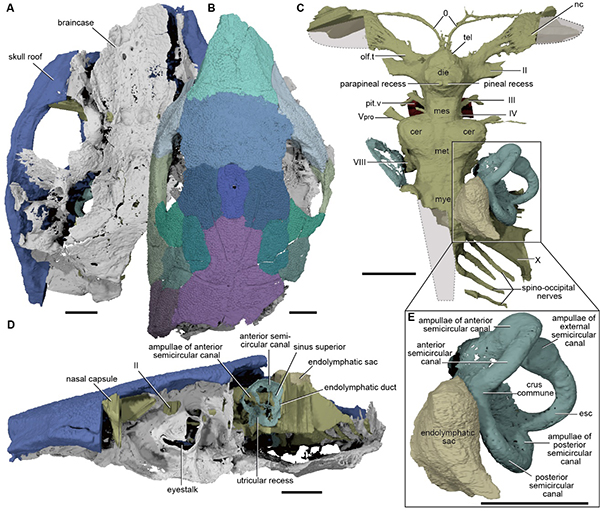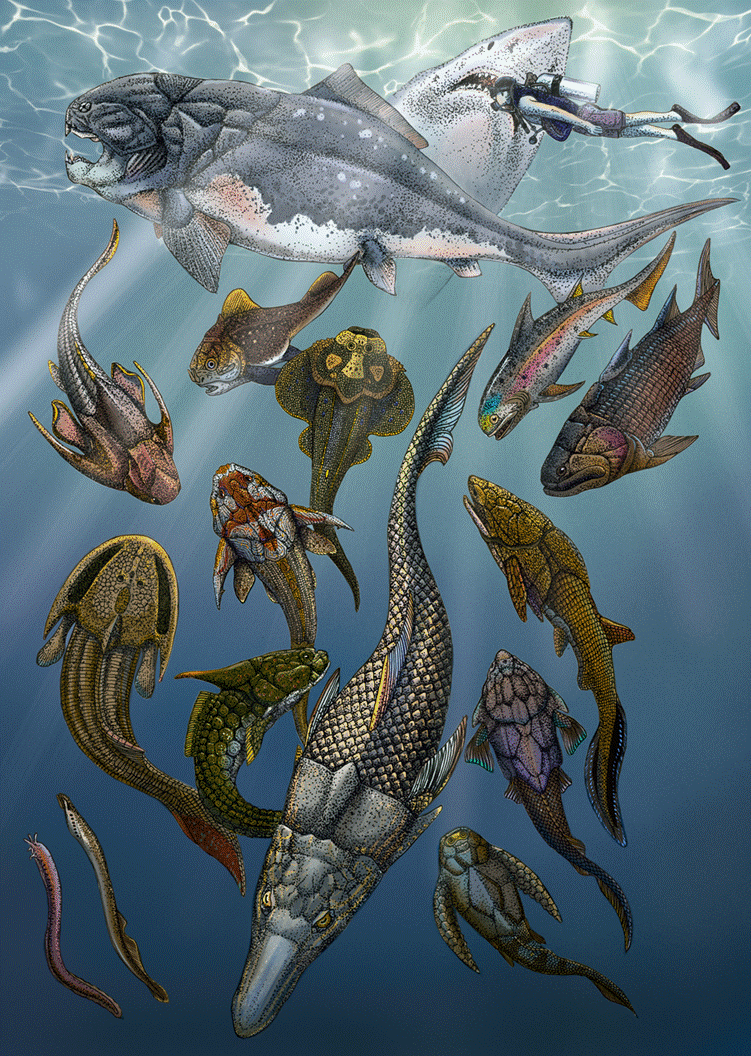New Findings on Devonian“Platypus Fish” Cast Light on Evolution of Modern Jawed Vertebrates
New findings on the brain and inner ear cavity of a 400-million-year-old platypus-like fish cast light on the evolution of modern jawed vertebrates, according to a study led by Dr. ZHU Youan and Dr. LU Jing from the Institute of Vertebrate Paleontology and Paleoanthropology (IVPP) of the Chinese Academy of Sciences.
The study was published in Current Biology on Jan 27.
Back in 1960s, Paleontologist Dr. Gavin C. Young found several fossils of a long-beaked fish, a type of placoderm, in the Burrinjuck limestones in Australia. He named the fish Brindabellaspis stensioi, and other people jokingly dubbed it "platypus fish" because of its long beak.
Most excitingly, the fossil of Brindabellaspis included the braincase, a kind of bony box inside the head that housed the brain and sensory organs. The morphology of the brain cavity suggested it was closely related to primitive jawless fishes.
A team of scientists from China, Australia, the UK and Sweden re-investigated these mysterious fossils using cutting-edge MicroCT scanning and digital reconstruction. These techniques use X-rays to look inside and digitally dissect fossils. The fossils can even be 3D printed, without causing any harm to the extremely fragile fossils.
Much to their surprise, the researchers found previously unseen areas inside the braincase that contain a critical pack of information: This ancient placoderm fish has an inner ear that resembles modern jawed vertebrates, including modern sharks and bony fishes, as well as the distant ancestors of humans.
Most placoderms have distinctive inner ear features, with a very large sac known as a vestibule placed in the center, separating all other components. In contrast, the inner ear of the ancestors of modern fishes and land-dwelling vertebrates is compact, with much more connection between different components. This latter condition is exactly what the researchers found inside the skull of Brindabellaspis. In fact, if you put the inner ear of Brindablleaspis and that of a human side to side, the upper part looks very similar, and is totally different from previously known placoderms.
Modern bony fishes and land-dwelling vertebrates have a closed endolymphatic system. Most early fishes, however, as well as modern sharks, have an open endolymphatic system that connects to the water outside. In placoderms, this connection was via a simple tube, whereas sharks have an endolymphatic sac that acts like a reservoir. Once again, the condition in Brindabellaspis is unlike that of other placoderms, with a sac resembling that of sharks.
As a sort of placoderm-bony-fish-shark chimera, Brindabellaspis has a profound impact on our understanding of the early evolutionary history of vertebrates. Scientists had long regarded placoderms as a natural group of their own. However, more recently, researchers began to suspect that placoderms do not form a natural group, and the origins of modern jawed vertebrates lay within the assemblage.
With a mosaic of undeniably primitive features and a surprisingly modern inner ear, Brindabellaspis lends support to two conflicting hypotheses of relationships. Using the parsimony method of analysis, most placoderms form a natural group, but some – including Brindabelllapsis – are found to be more closely related to living jawed fish groups. When Bayesian analysis is used, however, placoderms do not form a natural group, and Brindabellaspis is more removed from living jawed fishes.
Which hypothesis is closer to the truth? Dr. ZHU Youan, the first author of the paper, explains: "the simple answer is we don’t know yet. Molecular data suggest that jawed vertebrates arose in the Middle Ordovician, some 60 million years before Brindabellaspis was cruising the ancient reefs. The answer may be in that missing 60-million-year period, in which fossils are very rare."
Scientists are still piecing together this jigsaw puzzle, but one thing is for sure: There is much more critical information contained inside fossils than meets the eye, just waiting for X-rays to reveal it.
Link: https://doi.org/10.1016/j.cub.2020.12.046

Fig. 1 Fossil specimen of Brindabellaspis stensio as shown by MicroCT scanning. (Image by IVPP)

Fig. 2 Artistic rendering of Brindablleaspis (foreground) with diversified placoderms and other fishes. The white shark and human diver in the upper right corner represent modern jawed vertebrates. (Image by YANG Hongyu and ZHENG Qiuyang)
Download attachments: